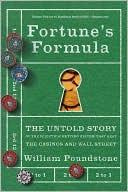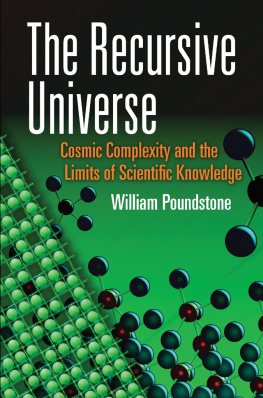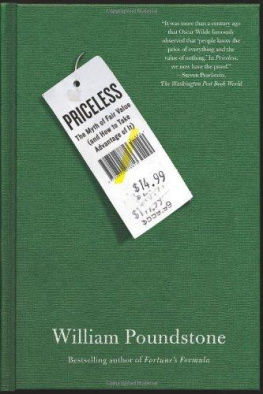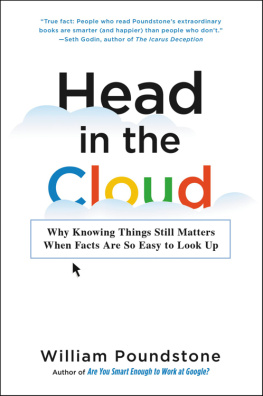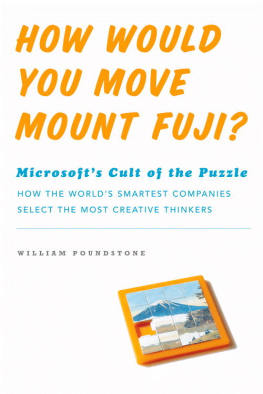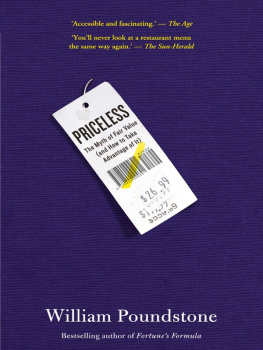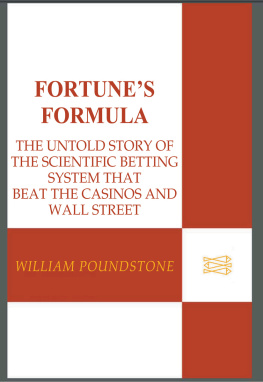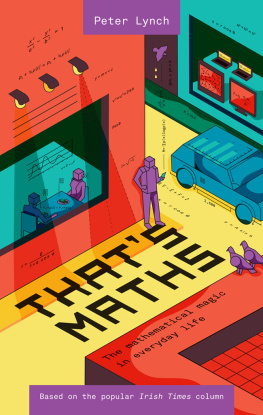William Poundstone - How to Predict Everything
Here you can read online William Poundstone - How to Predict Everything full text of the book (entire story) in english for free. Download pdf and epub, get meaning, cover and reviews about this ebook. year: 2019, publisher: Oneworld Publications, genre: Romance novel. Description of the work, (preface) as well as reviews are available. Best literature library LitArk.com created for fans of good reading and offers a wide selection of genres:
Romance novel
Science fiction
Adventure
Detective
Science
History
Home and family
Prose
Art
Politics
Computer
Non-fiction
Religion
Business
Children
Humor
Choose a favorite category and find really read worthwhile books. Enjoy immersion in the world of imagination, feel the emotions of the characters or learn something new for yourself, make an fascinating discovery.

- Book:How to Predict Everything
- Author:
- Publisher:Oneworld Publications
- Genre:
- Year:2019
- Rating:4 / 5
- Favourites:Add to favourites
- Your mark:
- 80
- 1
- 2
- 3
- 4
- 5
How to Predict Everything: summary, description and annotation
We offer to read an annotation, description, summary or preface (depends on what the author of the book "How to Predict Everything" wrote himself). If you haven't found the necessary information about the book — write in the comments, we will try to find it.
How to Predict Everything — read online for free the complete book (whole text) full work
Below is the text of the book, divided by pages. System saving the place of the last page read, allows you to conveniently read the book "How to Predict Everything" online for free, without having to search again every time where you left off. Put a bookmark, and you can go to the page where you finished reading at any time.
Font size:
Interval:
Bookmark:
HOW
TO
PREDICT
EVERYTHING
Also by William Poundstone
Head in the Cloud
How to Predict the Unpredictable
Are You Smart Enough to Work at Google?
Priceless
EVERYTHING
WILLIAM
POUNDSTONE

Heraclitus
that cats had two holes cut in their fur at precisely the spot where their eyes were.
Georg Christoph Lichtenberg
To Arthur Saint-Aubin
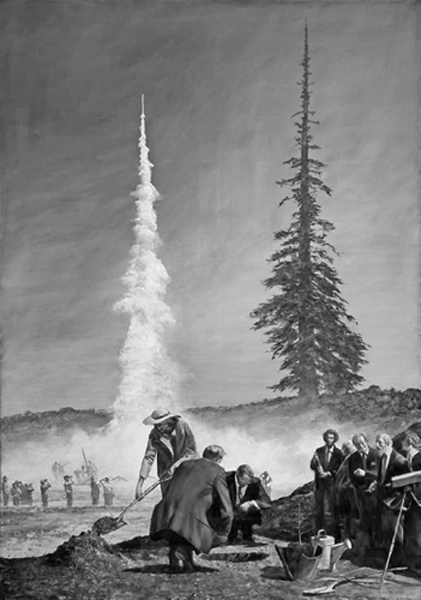
Mark Tansey, Achilles and the Tortoise, 1986. Mark Tansey
D iana Spencer met Charles, Prince of Wales, at a garden party in 1977. The couple fell in love and, after due diligence by their families, wed at St. Pauls Cathedral in July 1981.
American artist Mark Tansey incorporated Diana in his 1986 painting Achilles and the Tortoise. She is shown planting a hemlock, a sapling version of the mature tree behind her. Diana was often photographed planting trees, among them an apple tree she planted in honor of Isaac Newton.
In 1993 Diana came to the attention of American astrophysicist J. Richard Gott III. Gott had devised a mathematical formula for predicting the future. He wanted to test it on a celebrity marriage, and he chose Charles and Dianas because a magazine reported they were the most famous couple of the time. Gotts formula predicted a 90 percent chance that the royal marriage would end in as little as 1.3 more years. At the time, a royal divorce was considered almost unthinkable.
In December 1995 Queen Elizabeth II, incensed by tabloid reports of the couples extramarital affairs, wrote a letter advising Charles and Diana to divorce. The split was formalized on August 28, 1996. The following year, on August 31, 1997, Diana had a champagne supper in Paris with her new romantic interest, film producer Dodi Fayed. After leaving the restaurant, Diana and Dodi were killed when their alcohol-impaired chauffeur challenged paparazzi to a street race.
Tanseys picture contains at least four other portraits. To the right of Diana is mathematician Mitchell Feigenbaum holding a bottle of champagne, whose bubbles epitomize chaos theory. Feigenbaum, a pioneer of that theory, demonstrated that many phenomena are fundamentally unpredictable. In 1996 he founded Numerix, a firm using Bayesian probability to price financial derivatives for the so-called rocket scientists of Wall Street.
To the right of Mitchell, though easily missed, is the familiar face of Albert Einstein, shown in profile. The speeding rocket and slow-growing hemlock allude to Einsteins thought experiments of racing trains and light beams, used to develop his theory of relativity. Standing in front of Einstein is Benoit Mandelbrot, the IBM mathematician who described the concept of fractals. The hemlock tree and rocket blast are fractals, complex shapes in which each part resembles the whole.
Zeno of Elea, a Greek philosopher whose features are known from ancient busts, dangles a cigarette. Zeno propounded the paradox of Achilles and the Tortoise. Swift Achilles challenges the Tortoise to a footrace. The Tortoise demands a head start. Whenever Achilles catches up to where the Tortoise was, he still has a little farther to go. Thus, Zeno argued, Achilles can never overtake the Tortoise. For Zenos followers, the paradox was proof that something is deeply wrong about our understanding of space, time, and reality.
This book tells the story of another mind-boggling idea, the doomsday argument. As advanced by Gott and other scholars, it is a mathematical scheme to predict how long the human race will survive. The idea seems incredible to almost everyone at first encounter, but as we will see, it is not easily dismissed. In the following chapters I will present the cases for and against this provocative idea and attempt to evaluate them. I will show how the type of reasoning used in the doomsday argument has many potential applications. The argument has caused bright people to reflect on our fragile existence, our hopes, and our obligation to future generations and to reexamine the nature of evidence and the place of humans in the universe.
The end is near. Or not. The following chapters explore the doomsday argument, a simple line of reasoning that leads headlong to the conclusion that humanity does not have much time left. We meet the doomsayers and their critics and encounter such topics as the runs of Broadway plays, the populations of lemmings, and the riddle of Sleeping Beauty. We find that at least some doomsday calculations deserve to be taken seriously, and we assess our prospects.
S ix-year-old Helen Gregg, her nine-year-old sister, Frances, and their nine-year-old cousin, Ella Davies, never saw the atomic bomb that hit their playhouse. They were about six hundred feet away, in the South Carolina woods, on that bright spring day of March 11, 1958. The bomb was egg-shaped with stabilizing fins, a near-twin of the Fat Man bomb that struck Nagasaki. It annihilated the playhouse that Helen and Francess father had built for the girls, leaving a crater seventy-five feet across and thirty feet deep.
All the tons of earth thrown up in the air came back down in a hellish rain. It was that that injured the three girls, parents Walter and Effie Gregg, and their son Walter Jr. There were no deaths aside from a few chickens. The Greggs lived in a town called Mars Bluff. Today, sixty summers later, the crater is still visible.
Albert Madansky was a young statistics PhD from the University of Chicago, recruited by the RAND Corporation, a Santa Monica think tank contracting to the Pentagon. RAND wanted Madansky to tackle a problem that was easy to state but difficult to answer: What is the probability of a nuclear weapon detonating by accident?
The Mars Bluff incident, occurring the year after Madansky began work at RAND, was a prime topic of discussion. Madansky learned what the public had not. A B-47 Stratojet had left Hunter Air Force Base, Georgia, as part of a drill in handling atomic weapons. Early in the flight a red warning light came on in the cockpit, indicating that the bomb wasnt properly secured.
Copilot Bruce Kulka banged the warning light with the butt of his service revolver. The light went off. Later it came back on. Kulka went to the bomb bay to fix the problem. He reached around the bomb to engage a lock, hitting the wrong button. The weapon came loose, crashing through the bomb bay doors and plummeting fifteen thousand feet.
A fission bomb contains chemical explosives, TNT in this case, surrounding a core of uranium or plutonium. Unspeakable tragedy was avoided only because the bomb was unarmed, without any fissile material. The ground impact detonated the TNT, however, creating a massive conventional explosion.
Accidents like Mars Bluff had been happening for some time. Madansky was allowed to see a top secret list of sixteen dramatic incidents that had occurred between 1950 and 1958.
RANDs people worried about other scenarios. What if a bomb was lost and a civilian found it? What if an angry or unstable officer launched an atomic bomb without authorization? There were no statistics on such events because they had never happened.
In conventional statistical thinking, you cant assign a probability to something that has never happened. Whereof one has no data, one must remain silent.... But Madansky had studied statistics at Chicago with Leonard Jimmie Savage. Savage had been born with the name Ogashevitz, though it was generally agreed that Savage fit him better. He was brutally critical of anyone he judged less brilliant than himself, a group that seemed to cover just about everyone in the fields of mathematics and economics. Savage was a contrarian by nature. One of his most contrary pet ideas was Bayess theoreman obscure formula, named for an obscure minister of eighteenth-century England. Madansky was able to see that Bayess theorem offered exactly what RAND needed: a way to assign a probability to doomsday.
Next pageFont size:
Interval:
Bookmark:
Similar books «How to Predict Everything»
Look at similar books to How to Predict Everything. We have selected literature similar in name and meaning in the hope of providing readers with more options to find new, interesting, not yet read works.
Discussion, reviews of the book How to Predict Everything and just readers' own opinions. Leave your comments, write what you think about the work, its meaning or the main characters. Specify what exactly you liked and what you didn't like, and why you think so.

